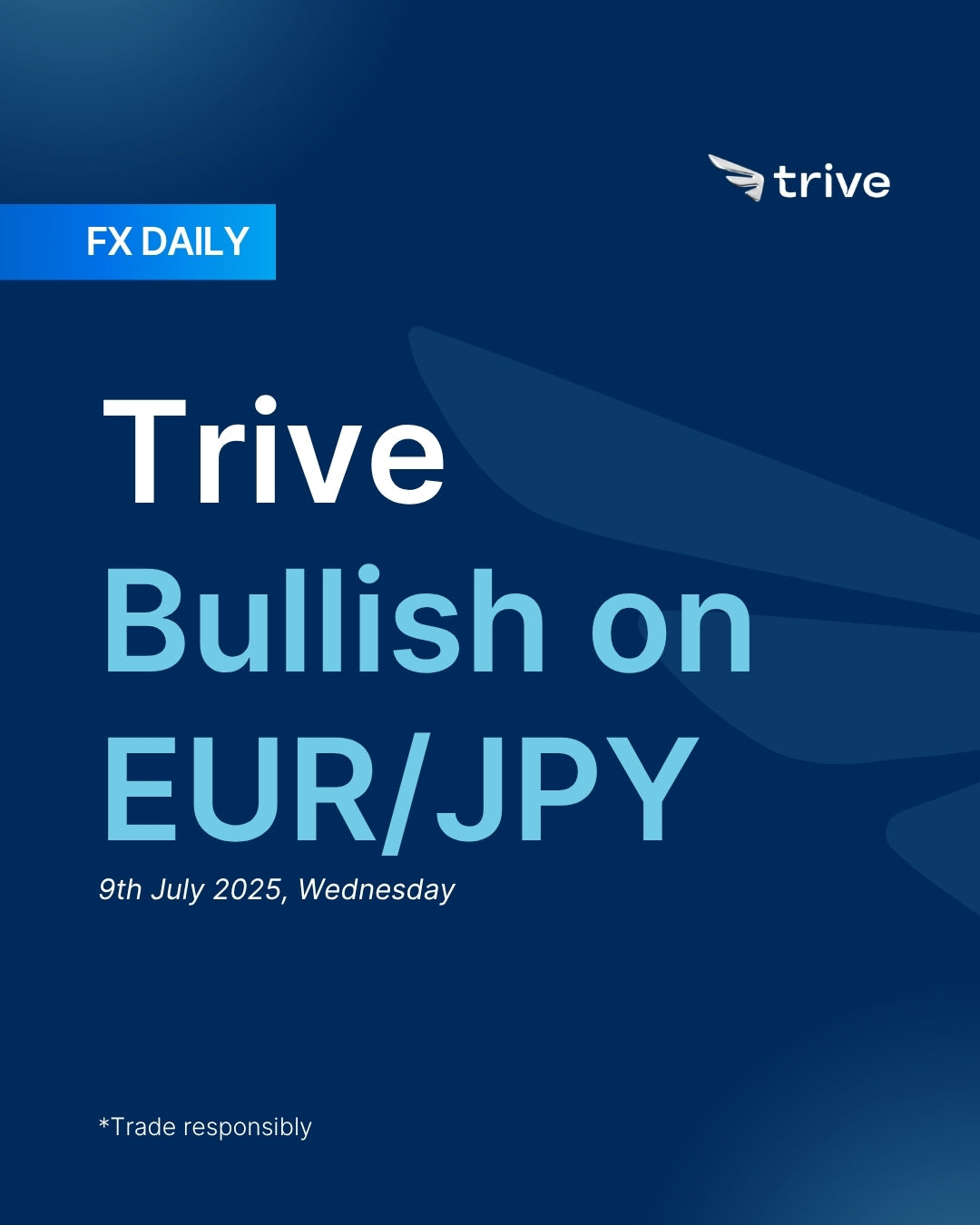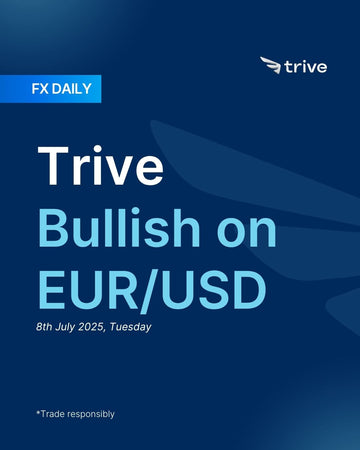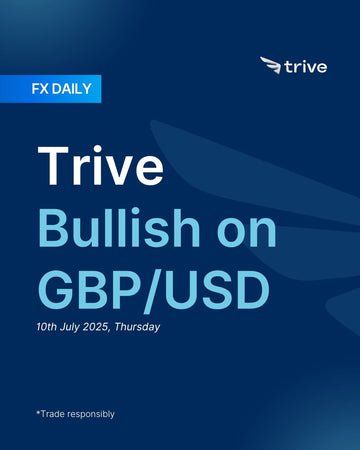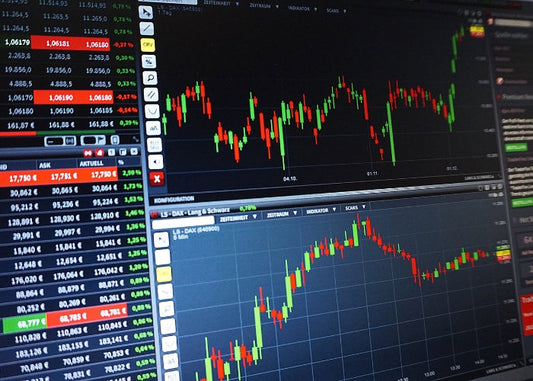FX Daily: Trive Bullish on EUR/JPY

EUR/JPY holds a bullish bias as euro strength contrasts with yen weakness. The euro is supported by stable inflation and data, while the yen is weighed down by US trade threats, BOJ’s dovish stance, and rising yield differentials. Risk-off may offer brief support to JPY, but fundamentals favor EUR upside.
EUR: Buy in dips
The Euro had a week of two halves, initially rising to a multi-year high before being sharply sold off as ECB officials pushed back against the currency’s strength and strong US jobs data revived demand for the dollar. The week began with solid gains, as the Euro took advantage of a broadly weaker US Dollar to break above 1.1800 and briefly touch a high near 1.1830. But this upward momentum quickly faded when several ECB policymakers, speaking at the Sintra forum, voiced concern about how fast the Euro was rising. The real turning point came on Thursday, when a strong US Non-Farm Payrolls report triggered a sharp reversal in EUR/USD, dragging it back down toward 1.1700. By the end of the week, the Euro’s earlier strength had turned into a liability, weighing on the currency’s performance.
The biggest Euro-specific factor was the ECB’s verbal pushback on the currency’s strength. At the Sintra forum, ECB officials increased their warnings about the rapid appreciation. ECB Vice President de Guindos made it clear that a move above 1.20 in EUR/USD would be “complicated,” giving the market a clear signal about the level of discomfort. These comments set a limit in traders’ minds and raised concerns about potential future action.
The ECB minutes released on Thursday reinforced these concerns. They highlighted that a stronger Euro increases the risk of inflation falling below the bank’s 2% target. Policymakers such as Kazaks suggested that further Euro gains could support the case for another rate cut. Rehn and Wunsch also flagged risks to inflation, adding to the dovish tone.
Still, the Euro’s move was mostly shaped by what happened with the US Dollar. The Euro gained ground early in the week as the DXY weakened, but it reversed quickly when the strong US jobs report forced markets to rethink their expectations for Fed rate cuts. The data suggested the US economy was still strong, leading traders to unwind long EUR/USD positions aggressively.
On the data front, Eurozone figures took a back seat and didn’t move the market much. Inflation for June was in line with forecasts, with headline HICP at 2.0% and core inflation at 2.3%. While this showed inflation was at the ECB’s target, it didn’t do much to ease worries that inflation could slip again in the future. Activity data was stable, with June’s final Composite PMIs holding up. However, the unemployment rate in May unexpectedly rose to 6.3%, adding a slight note of concern.
Trade uncertainty also lingered in the background. With the US tariff deadline approaching on July 9th, markets watched for signs of progress in the ongoing US-EU trade talks. The EU indicated it was ready for a deal, particularly pushing for exemptions on autos and steel, but also stated it was prepared if no deal came through. European Commission President von der Leyen’s comments summed up the mood: open to agreement, but bracing for the possibility of escalation.
The euro has solid footing after June’s HICP inflation held right at the ECB’s 2% goal, giving policymakers little reason to rush into cuts and lending steady support to the currency. PMI readings stuck just above 50, which shows activity is stable and helps keep the euro from drifting lower. Even a strong US NFP report only paused euro strength rather than reversing it, underlining its underlying resilience. ECB speakers have warned about an overly strong euro, but their balanced tone suggests they’ll let markets set the pace rather than force a weaker currency.
Healthy trade flows with the UK and Asia, plus the prospect of modest growth in the autumn, should nudge the euro gently higher. On balance, the euro’s baseline bias is weakly bullish to neutral, more likely to grind upward.
JPY: Tariffs threat
The Japanese Yen had a turbulent week, caught between its usual safe-haven appeal and rising fears of a trade conflict with the United States. It started off strong, supported by solid results from the Tankan business survey and a general risk-off mood in global markets, which pushed USD/JPY below the 143.00 level. But this early strength didn’t last. As the week progressed, President Trump intensified his trade rhetoric, first casting doubt on a US-Japan deal being reached by the July 9th deadline and then threatening tariffs as high as 30–35% on Japanese imports. This specific threat to Japan, along with reports that the US was prioritizing a trade deal with India instead, pressured the Yen and caused USD/JPY to climb back above 144.00.
The situation worsened on Thursday after a strong US Non-Farm Payrolls report boosted US Treasury yields, prompting a surge in the dollar and driving USD/JPY above 145.00. Although the Yen regained some ground at the end of the week as broader trade-related fears returned, it still ended the week significantly weaker, mostly due to concerns over a direct trade conflict with the US.
The biggest driver was the sharp escalation in trade tensions. Trump questioned whether a deal with Japan could be reached in time and mentioned the possibility of high tariffs, while also criticizing Japan for not buying enough US rice. On Friday, he said the US would begin sending out tariff letters to several countries. Reports from the Nikkei indicated that the US was now focusing on finalizing a trade agreement with India first, pushing Japan further down the priority list. This delay dampened hopes for a quick resolution and added to pressure on the Yen.
In response, Japanese officials emphasized that they would defend national interests. Tariff Negotiator Akazawa and Chief Cabinet Secretary Hayashi both stated that Japan would not sacrifice its agricultural sector just to meet a deadline.
Meanwhile, the Bank of Japan remained cautious. At the ECB’s Sintra forum, Governor Ueda repeated that inflation was still running below the 2% target, and board members echoed a patient stance. Masu described himself as centrist on policy, while Takata acknowledged that while the target is close, the BoJ still needs to keep its easy policy in place. The growing trade tensions limited any room for tightening, keeping expectations for near-term policy moves firmly in check.
On the economic side, the second-quarter Tankan survey gave the Yen a boost early in the week. The Large Manufacturers Index beat forecasts, coming in at 13 compared to the expected 10. The outlook and capital spending plans also looked solid, pointing to underlying business strength. Other data was mixed. May’s Industrial Production missed expectations, but Household Spending beat forecasts. The final Rengo trade union survey showed an average wage increase of 5.25% for fiscal 2025, a strong sign for domestic demand, though it was largely ignored as markets focused on the external risks.
Throughout the week, the Yen was torn between its traditional safe-haven role and being a direct target of US trade pressure. While it benefited from general risk aversion at the start of the week and again on Friday, it was punished mid-week when Washington’s threats were aimed squarely at Japan. After the US jobs report, surging Treasury yields created a wide yield gap that led to heavy Yen selling, pushing USD/JPY to its weekly high. The sharp contrast between low Japanese yields and rising US rates added to the pressure, leaving the Yen on the defensive despite pockets of broader market caution.
The yen will probably stay under pressure as talks with the U.S. over trade and possible tariffs continue. However, it can still strengthen temporarily whenever investors grow worried about global markets. But it’s also underperforming stronger currencies because of soft domestic data and lingering doubts about how far the Bank of Japan will go with rate hikes. The yen did benefit when oil prices fell, improving Japan’s trade outlook, but its gains were limited by the lack of a clear domestic catalyst. So for now, we expect the yen to stay somewhere in the middle, stronger than the weakest currencies but weaker than the strongest.
 EUR/JPY 4H
EUR/JPY 4H
Disclaimer
This material is provided for informational purposes only and does not constitute financial, investment, or other advice. The opinions expressed in this material are those of the author and do not necessarily reflect the views of Trive International. No opinion contained in this material constitutes a recommendation by Trive International or its author regarding any particular investment, transaction, or investment strategy. This material should not be relied upon in making any investment decision.
The information provided does not consider the individual investment objectives, financial situation, or needs of any specific investor. Investors should seek independent financial advice tailored to their individual circumstances before making any investment decisions. Trive International shall not be liable for any loss, damage, or injury arising directly or indirectly from the use of this information or from any action or decision taken as a result of using this material.
Trive International may or may not have a financial interest in the companies or securities mentioned. The value of investments may fluctuate, and investors may not get back the amount they originally invested. Past performance is not indicative of future results.
For more information about Trive International, please visit http://trive.com/int
Additional Information
Investing involves risk, including the potential loss of principal. Diversification and asset allocation strategies do not ensure a profit or guarantee against loss. The content in this material is subject to change without notice and may become outdated or inaccurate over time. Trive International does not undertake any obligation to update the information in this material.
By accessing this material, you acknowledge and agree to the terms of this disclaimer. If you do not agree with these terms, please refrain from using this information.
कोई टिप्पणी नहीं
Home
Trive
TriveHub





0 टिप्पणियाँ